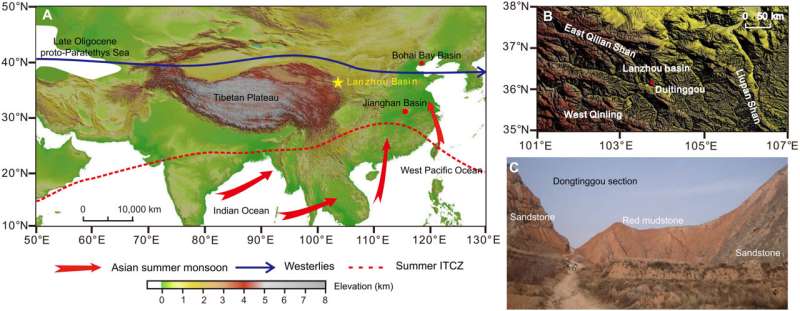Fig. 1. Site location map and photographs.(A) Topographic map of Asia with schematic summer monsoon, westerlies, and summer intertropical convergence zone (ITCZ) at present (11) and with the Late Oligocene proto-Paratethys Sea that was located west of the Tibetan Plateau (26). (B) Topographic map of the Lanzhou Basin and surrounding mountains with the location of the studied Duitinggou section (red solid circle). (C) Field photograph of the tilted to the west (~30°) Duitinggou section. The left-hand side (west) is younger than the right-hand side (east). Photo credit: Hong Ao, Institute of Earth Environment, Chinese Academy of Sciences. Credit: DOI: 10.1126/sciadv.abk2318
Researchers from China, the U.K., Netherlands, and Australia have revealed orbital-scale Asian monsoon variability and dynamics under conditions of high atmospheric CO2 concentrations and a warm climate during the late Oligocene.
The study was published in Science Advances on Dec. 15. It was led by Prof. Ao Hong from the Institute of Earth Environment of the Chinese Academy of Sciences.
Across the Eocene–Oligocene transition, ~34 million years ago (Ma), Earth transitioned from a warm greenhouse state with no permanent polar ice sheets to a unipolar icehouse state with continental-scale ice sheet development on Antarctica. Despite a certain amount of cooling during this transition, Earth was substantially warmer than it is today.
The Oligocene between 33.90 and 23.03 Ma represents the first epoch in the newly established unipolar icehouse world. The atmospheric CO2 concentrations at that time were between ~400 and ~800 parts per million (ppm), with an average global sea surface temperature 8 degrees Celsius higher than today and an ice-free Northern Hemisphere.
"Study of monsoon variability and dynamics in the Oligocene high-CO2 world has important implications for the rapid out-of-equilibrium, present-day monsoon responses to an anthropogenic CO2 increase," said Prof. Ao, the principal investigator of the study. Such research also helps to improve prediction of future hydrological changes following the sustained atmospheric CO2 and temperature increases projected by the Intergovernmental Panel on Climate Change (IPCC) Sixth Assessment Report.
The well-exposed fluvial-lacustrine sedimentary succession of the Lanzhou Basin on the northeastern Tibetan Plateau margin spans virtually the entire period from the Eocene to the Miocene. It provides an excellent opportunity to study the sedimentary signature of climate during past periods of persistently warmer-than-present conditions.
The researchers established 4-Myr-long summer monsoon records (magnetic susceptibility and rubidium-to-strontium ratio) continuously spanning the period from ~28.1 to ~24.1 Ma at ~4-thousand-year (kyr) resolution from a well-developed distal alluvial sedimentary sequence in the Lanzhou Basin. These records reveal orbital-scale Asian monsoon variability in the high-CO2, warm-climate world of the Late Oligocene, 20 Myr before Northern Hemisphere glaciation.
They found that Asian summer monsoon precipitation on the northeastern Tibetan Plateau margin was characterized by prominent short (~110-kyr) and long (405-kyr) eccentricity cycles between ~28.1 to ~24.1 Ma, with a weak expression of obliquity (41-kyr) and precession (19-kyr and 23-kyr) cycles.
Based on land-sea correlations and astronomical forcing theory, this orbital-scale regional monsoon precipitation variability during the late Oligocene was probably controlled by a combination of eccentricity modulation of solar insolation, a low-latitude forcing, and glacial-interglacial Antarctic ice sheet fluctuations, a high-latitude forcing.
The combined low- and high-latitude forcing drove the eccentricity-paced precipitation variability by governing regional temperatures, water vapor loading in the western Pacific and Indian Oceans, and Asian monsoon intensity and displacement.
This finding implies that the Asian monsoon may become increasingly susceptible to sustained global warming as anthropogenic emissions continue to increase.
More information: Hong Ao et al, Eccentricity-paced monsoon variability on the northeastern Tibetan Plateau in the Late Oligocene high CO 2 world, Science Advances (2021). DOI: 10.1126/sciadv.abk2318
Journal information: Science Advances
Provided by Chinese Academy of Sciences
























